Chickpea, also known as Bengal gram or chana, is a nutritious and flavorful legume widely cultivated and consumed worldwide. It is a good source of protein, dietary fiber, and other essential nutrients. It can be used in various dishes, such as curries, soups, and salads. They are native to South Asia and the Middle east. Let’s check out the best package practices to grow Chickpeas.
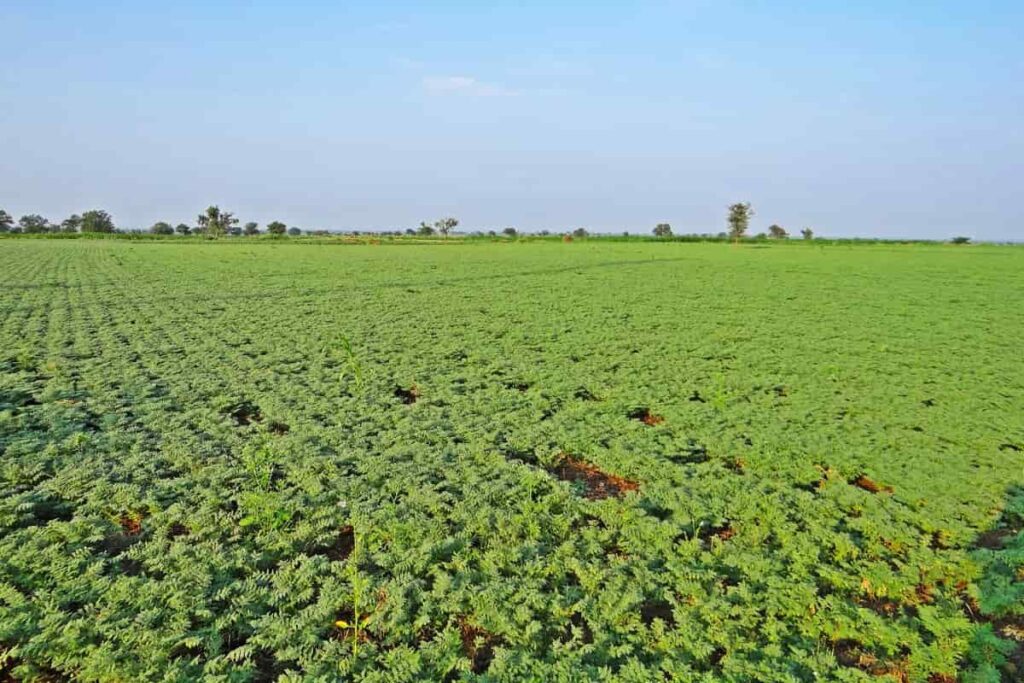
The Chickpea is grown in many parts of the world, including:
- Asia: India, Pakistan, and Turkey are the top chickpea producers in Asia.
- North Africa and the Middle East: Morocco, Egypt, and Syria are the significant chickpea producers in this region. Spain, Italy, and Greece are the leading producers of chickpeas in Europe.
The United States, Mexico, and Canada are the primary producers of chickpeas in North America. Argentina, Brazil, and Peru are the significant producers of chickpeas in South America. Australia is a significant producer of Chickpeas, with most of the production occurring in New South Wales, Queensland, and Victoria.
This pulse is consumed whole, fried or boiled and salted, or in the shape of a split pulse, which is cooked and consumed. Chickpea is thought to have medicinal properties and is used to purify the blood. The protein content is approximately 21%, 61.5 % carbs, and 4.5 % fat. Chana is abundant in calcium, iron, and niacin.
About Chickpea plant (Bengal Gram/Chana)
The chickpea plant, called Cicer arietinum, is an annual legume native to Southwestern Asia. It belongs to the Fabaceae family. It is often grown for its edible seeds, which are high in protein and dietary fiber. Chickpea is also called Garbanzo bean, Bengal Gram, Chana, and Egyptian pea.
It is mainly eaten for its protein content. Chickpea plants are bushy, can grow to around 20-50 cm, and have hairy, pinnate leaves with blue-green leaflets. It produces small, white, or pink flowers that eventually become pods containing the seeds. It is a cool-season legume that grows best in temperatures 18-24°C during their growing season. They can tolerate slightly cooler temperatures, down to about 10°C.
Importance of Chickpea cultivation
- Nutrition: Chickpea are a great source of protein, fiber, and various vitamins and minerals, including iron, zinc, and folate. They are low in fat and have a low glycemic index, making them an excellent alternative for people with diabetes or anyone wanting to control their blood sugar levels.
- Environmental benefits: Chickpea are a sustainable and eco-friendly crop. They require little water to grow and can be grown in various climates, making them suitable crops for areas that may not be suitable for other crops. They also have a low carbon footprint and can help reduce greenhouse gas emissions through their ability to fix nitrogen in the soil, reducing the need for chemical fertilizers.
- Versatility: Chickpeas can be found in various meals, salads, soups, hummus, and falafel. They are also a popular source of protein in vegan and vegetarian cuisine.
In case you missed it: How to Grow Pigeon Pea/Red Gram/Toor Dal: Cultivation Practices and Production Management
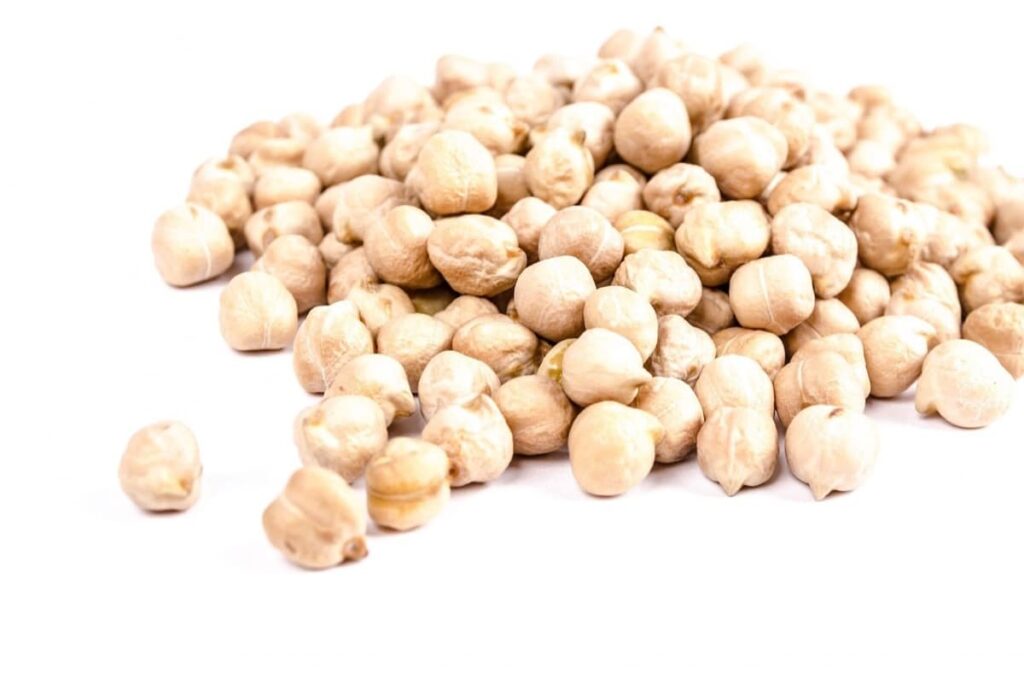
Best package practices to grow chickpeas: A step-by-step guide for beginners
Different Varieties/Hybrids of Chickpea
- Desi Chickpea: This is the most widely cultivated variety of chickpeas, with small, dark seeds and a thick skin. It is primarily grown in India, Pakistan, and Ethiopia.
- Kabuli Chickpea: This variety is characterized by large, light-colored seeds and thin skin. It is mainly grown in the Mediterranean region, the Middle East, and the Americas.
- Bengal Gram: This variety is small, round, and yellowish. It is primarily grown in India and is used in various dishes, including dal and curry.
- Chana Masoor: This is a hybrid variety of chickpeas developed by crossing the Desi and Kabuli varieties. It has a medium-sized seed and is mainly grown in India and Pakistan.
- Garbanzo: This is another hybrid variety developed by crossing Desi and Kabuli varieties. It has a medium-sized seed and is primarily grown in the Americas.
- Kala Chana: This variety is small, dark, and round, with thick skin. It is mainly grown in India and is used in various dishes, including chaat and chole.
- Popular varieties of Chickpeas in India are Gram 1137, PBG 7, Pant G 114, Pusa 209, Pusa Chamatkar, and Aadhar (RSG-963).
Field/ soil preparation for Chickpea cultivation
Before planting, it is essential to test the soil to determine the pH, nutrient levels, and organic matter content. It will help identify potential deficiencies that need to be addressed before planting. Soils with a light to medium texture that drain well are ideal. Make sure the land is free of clods and weeds.
Chickpea grows best in well-drained soils with good water retention. Therefore, it is important to till the soil to a fine tilth to ensure good seed-soil contact and facilitate water infiltration. Bengal gram cultivation requires soil that ranges from sandy loam to clay loam. Soils with water logging issues are unsuitable for cultivation. Saline and alkaline soils are unsuitable. Chickpea requires a pH between 5.5 and 7 for cultivation.
In case you missed it: Fertilizer Schedule for Fruits: Organic, Chemical, How and When to Apply

Temperature, climatic, and rainfall requirements for Chickpea cultivation
- Temperature range: It is a cool-season legume that grows best in temperatures 18-24°C and can also grow up to 30°C during its growing season. They can tolerate slightly cooler temperatures, down to about 10°C. The sowing Temperature range is 20°C to 26°C, and the Harvesting Temperature range is 30°C to 32°C.
- Rainfall: Chickpeas do not require a lot of rainfall, but they need a consistent water supply. Rainfall ranges between 60 to 90 cm. However, they can tolerate dry conditions as long as they are irrigated regularly.
- Climatic conditions: Chickpeas prefer a dry, arid climate with low humidity and well-draining soil. They are drought-resistant and can tolerate dry conditions but need water to grow properly.
Propagation of Chickpea/ Bengal Gram
Chickpeas can be propagated through seed planting. Sowing at the proper time is essential because early sowing results in excessive vegetative growth and crop wilt. In contrast, late sowing results in poor vegetative growth and inadequate root development. Seed Spacing should be planted 10 cm apart, with a 30-40 cm gap between rows. Sowing Depth: Plant the seed 10-12.5 cm deep. The optimum Sowing period for chickpeas is in the first two weeks of October is considered best for chickpea planting.
Seed rate and sowing method for Chickpea cultivation
For desi varieties, use a seed rate of 15-18 kg/acre, and 37 kg/acre for Kabuli varieties. Standard sowing methods are line sowing and direct sowing. Using a seed drill for sowing, maintain a spacing of 30 x 10 cm.
Seed treatment in Chickpea
Mix Trichoderma at 2.5 kg/acre with 50 kg decomposed cow manure and covered for 24-72 hours. To control soil-borne disease, Inoculate the seed with Mesorhizobium to boost production and yield by 7%.
Manure and fertilizer applications in Chickpea
Manures are an organic source of plant nutrients rich in nitrogen, phosphorus, and potassium (NPK). Manure is also a good source of micronutrients and organic matter, which helps to improve soil structure and fertility. Manure can be applied to the soil before planting or during the growing season, depending on the type used.
Drill all fertilizers during sowing: 6 kg N (13 kg Urea), 8 kg P2O5 (50 kg SSP). It is recommended to apply fertilizers when the crop is at the vegetative or reproductive stages, as these are the stages when the crop has a high demand for nutrients. Di-ammonium phosphate should be used if the soil requires nitrogen and phosphorous (18-46-0).
In case you missed it: Drip Fertigation in Fruit Crops: Schedule of Drip Fertigation, Pros, and Cons
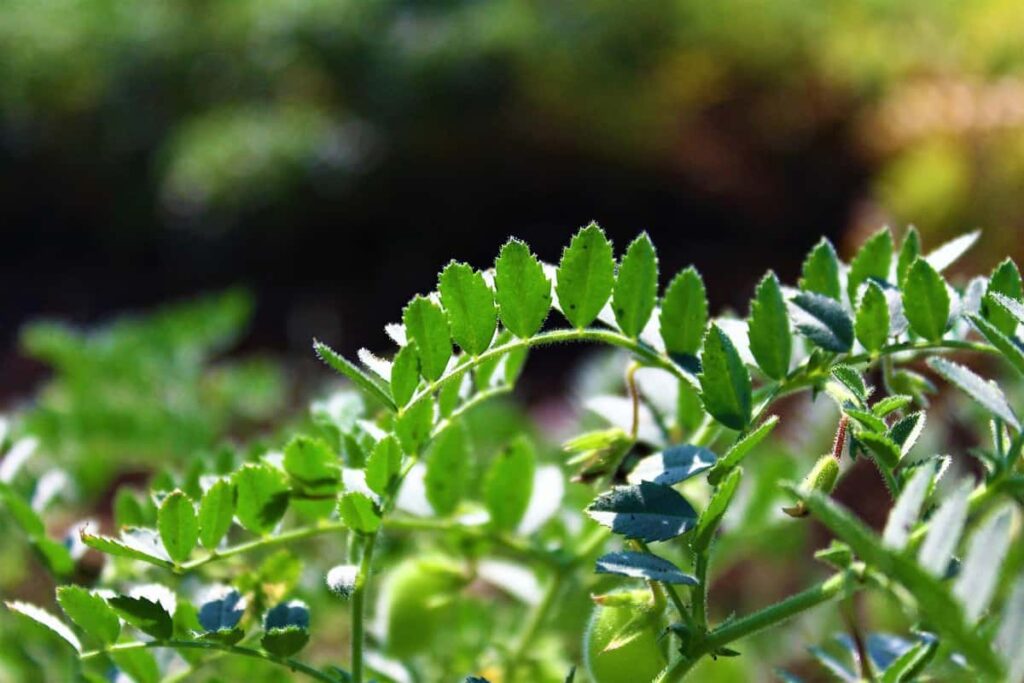
Weed control in Chickpea
To keep weeds low, weed by hand or with a wheel hoe 25-30 days after sowing and again, if necessary, after 60 days. Pre-emergence application of Pendimethalin @ 1Litre/200Litre water on the third day after planting for one-acre ground for excellent weed control. It will aid in the control of annual weeds. Hand weeding or intercultural with a hoe is usually preferable to herbicides in cases of low infestation because intercultural operations promote soil aeration. There are numerous strategies for weed management in chickpea crops:
- Cultural methods include proper row spacing and seed rate, timely sowing and planting, and crop nutrition and irrigation.
- Chemical methods: Herbicides can be used to control weeds in chickpea crops. However, care should be taken to use the suitable herbicide at the right time and in the correct dosage, as overuse or improper use can damage the crop.
- Mechanical methods: Hand weeding, hoeing, and mechanical weeders can be used to remove weeds manually. However, these labor-intensive methods may not effectively control larger weed populations.
- Biological methods: The use of cover crops and green manures can help to suppress weed growth and improve soil health. Additionally, the use of biopesticides and plant extracts can help to control weeds in a more environmentally friendly manner.
Different cropping systems and intercropping in Chickpea
- Intercropping: This is a cropping system where different crops are planted in the same field simultaneously, but they are planted in such a way that they do not compete for resources like water and nutrients. For example, chickpeas could be intercropped with beans or lentils. This method allows for a diverse range of crops to be grown and can increase overall yield and profitability.
- Rotational cropping: This is a technique in which different crops are rotated in the same field. For example, chickpeas could be rotated with wheat or mustard. This method allows for better soil management and can help to prevent soil degradation.
Irrigation in Chickpea
Pre-sowing irrigation is recommended where irrigation facilities are available. It will ensure proper crop germination and growth. After that, offer a second irrigation during pre-flowering and another during pod development. In the event of early rain, delay irrigation and provide as needed. Excessive watering promotes vegetative growth while decreasing grain yield. It also does not tolerate water stagnation in the field; therefore good drainage is required.
Disease management in Chickpeas
Chickpea is susceptible to various diseases that can affect their growth and yield. Some common diseases of Chickpeas include:
- Ascochyta blight and Rust: This disease is caused by the fungus Ascochyta rabiei, which causes leaf and stem lesions and can lead to the premature death of plants.
- Fusarium wilt and gray mold: This disease is caused by the fungus Fusarium oxysporum, which infects the plant’s vascular system, leading to wilting and death.
- Root rot is caused by fungi such as Pythium and Rhizoctonia, which attack the plant’s roots, causing them to rot and resulting in diminished growth and yield.
- The Erysiphe fungus causes powdery mildew. It produces a white, powdery covering on the plant’s leaves and stem, reducing photosynthesis and yield.
In case you missed it: Lentil Farming Practices: Cultivation and Production Guide for Beginners
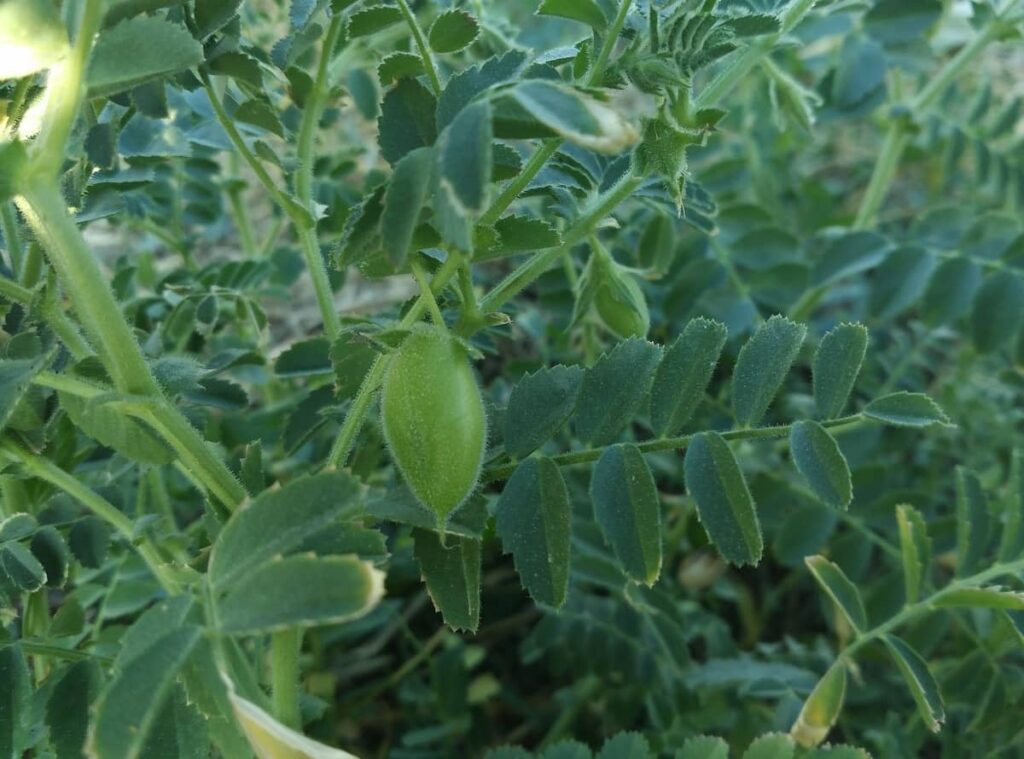
To manage these diseases, following good cultural practices such as rotating crops, using disease-free seeds, and practicing proper field hygiene is essential. Chemical controls such as fungicides may also be used. Still, they should be used carefully to avoid negative environmental and human health impacts.
Pest management in Chickpea
Pest management in Chickpea involves several strategies to prevent and control the damage caused by pests such as insects, Termites, Cutworms, Gram pod borers, and mites. Some of the key strategies include:
- Crop rotation: This involves planting chickpeas in a different location each year to avoid the buildup of pests in the soil.
- Planting-resistant varieties: Some chickpea varieties are resistant to certain pests, making them less susceptible to damage.
- Chemical control: Pesticides can be used to control pests, but they should be used sparingly and only as a last resort.
- Biological control: it involves using natural predators such as ladybugs to control pests.
- Cultural control: Practices such as proper irrigation and fertilization can help reduce pest populations.
- Early detection: Regularly scouting fields and monitoring for pests can help catch infestations early and allow for timely control measures.
- Crop sanitation: Cleaning up crop debris and removing infected plants can help reduce the spread of pests and diseases.
Harvesting and threshing in Chickpea
Harvesting chickpea involves waiting until the plants fully mature and the pods have turned golden brown. The plant is ready to harvest after 120-150 days of sowing and when the leaves turn reddish brown and begin to shed. With a sickle, cut the plant. For five to six days, sundry the harvested crop. After adequate drying, thresh the plants by beating them with sticks or trampling them under the feet of bullocks. The pods should be dry and brittle and easily break open when pressed.
In case you missed it: Growing Spinach Organically in Telangana: Cultivation Practices and Production Guide
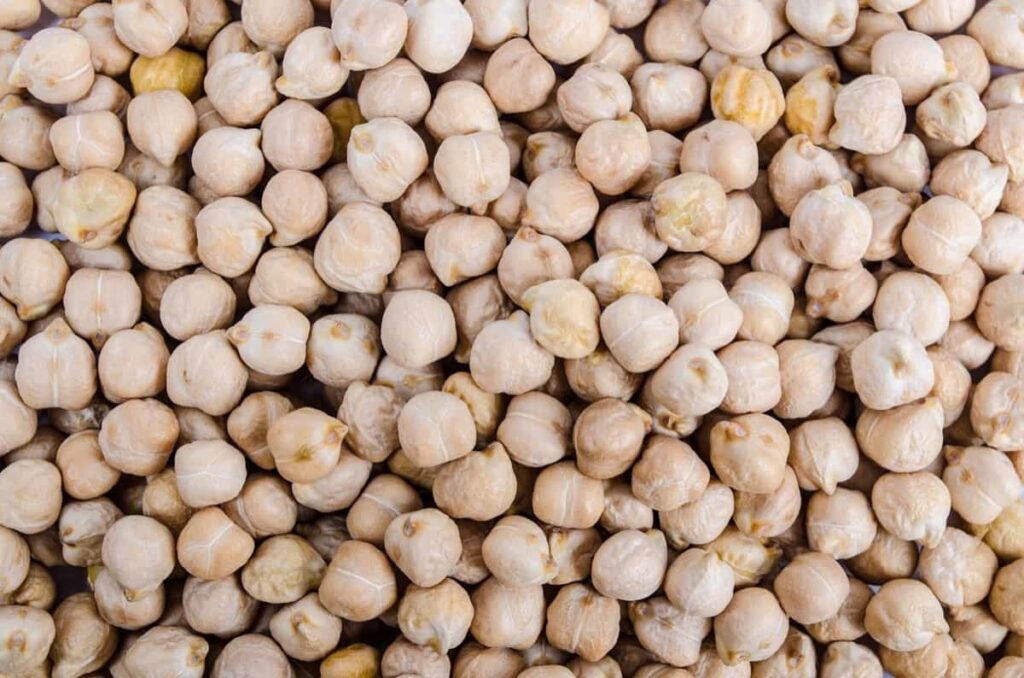
To harvest the chickpea pods, the plants can be cut at the base and removed by hand. Alternatively, the roots can pull the plants up, and the pods can be removed afterward. Threshing Chickpea involves separating the pods from the grains. It can be done by beating the pods against a hard surface or using a thresher machine. The grains can then be cleaned and sorted for storage or further processing. Before storing harvested crop grains, they must be well-dried. Also, take precautions to avoid a pulse beetle infestation in storage.
Chickpea yield per acre
Chickpea production per acre can vary substantially based on factors such as chickpea variety, growing circumstances, and agricultural strategies. On average, the yield of chickpeas per acre ranges from 6.5 to 8.0 quintals/acre.
- How to Raise Pigs in Your Own Backyard: A Comprehensive Guide
- Budget Friendly Sheep Shed Ideas: Cheap and Low-Cost Tips
- How Much Do Cattle Farmers Make: Revenue Streams in Cattle Farming
- Management Pests and Diseases in Your Cotton Field
- Sheep Farming Business Plan for Beginners
- Aquaponic Farming at Home: A Step-By-Step Guide
- Profitable Village Farming Business Ideas in 2024
- High-Yield Aquaculture: Fast-Growing Fish for Farming
- Effective Fish Pond Construction Techniques for Beginners
- Irrigation and Water Management in Pineapple Farming
- Blossom to Harvest: Mastering Flowering and Pollination in Papaya Farming
- Pig Fattening Essentials: From Selection to Sale for Beginners
- Raising Wagyu Cattle: A Complete Guide for Premium Beef Production
- Soil Types and Their Water Holding Capacity
- Optimizing Irrigation Schedules for Coconut Groves for Enhanced Yield
- Espresso Your Garden: Coffee Grounds for Healthier Acid-Loving Plants
- The Best Soil Mix for Snake Plants: How to Mix Your Own Snake Plant Soil
- Green Thumb Success: Expert Tips for Cultivating Greenhouse Beans All Year Round
- Bloom All Year Round: The Ultimate Guide to Indoor Hyacinth Care
- Eco-Friendly Gardening: How to Make Liquid Fertilizer from Kitchen Waste
- Ultimate Guide to Grow Anise in Pots: Explore Seed Propagation to Harvesting
- Guide to Raising Chester White Pigs: Discover Breed Facts to Growth Management
- Mastering the Elegance: The Ultimate Guide to Weeping Cherry Tree Care, Planting, and Maintenance
- Ultimate Guide to Planting Garlic in Grow Bags: Growing Strategies for Beginners
- How to Fix Spider Plant Leaf-Related Problems: Natural and Organic Remedies
- 10 Reasons Why Your Tulsi Plant is Shedding Leaves: Home Remedies and Solutions
- Optimizing Growth and Yield: The Advantages of Palm Bunch Ash Fertilizer
- Utilizing Neem Oil Extract as a Natural Pesticide for Hydrangea
- From Soil to Harvest: Various Ways in Which Farmers Can Use AI Tools
- Steps to Encourage and Induce Citrus Flowers: A Comprehensive Guide
- How to Fix Snake Plant Leaf-Related Issues: Natural and Organic Remedies
- Transform Your Garden into a Fragrant Oasis with Raat Ki Rani (Night Blooming Jasmine)
- Discover the Ideal Chicken Breeds for Philippine Farms
- How to Create a Poultry Egg Farm Business Plan for Profits
- Grow Lemon Cucumbers Like a Pro: Insider Techniques for Bountiful Yields
- Ultimate Guide to Caring for Your Pink Princess Philodendron: Tips for Thriving Variegation
